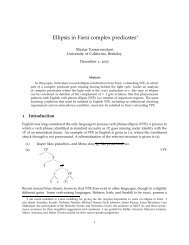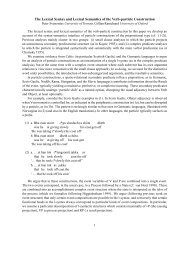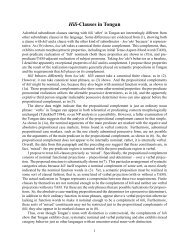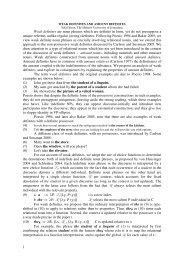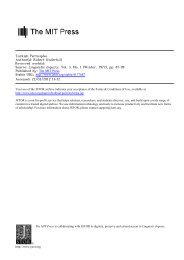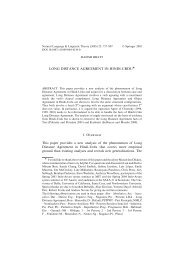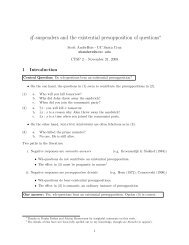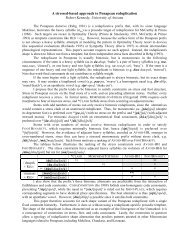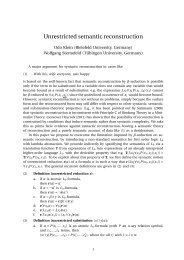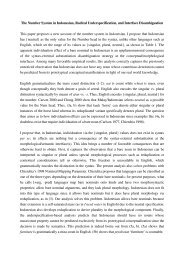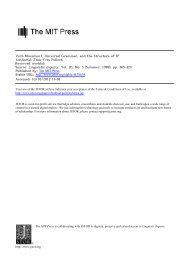Syntax III Assignment I (Team B): Transformations Julie Winkler ...
Syntax III Assignment I (Team B): Transformations Julie Winkler ...
Syntax III Assignment I (Team B): Transformations Julie Winkler ...
Create successful ePaper yourself
Turn your PDF publications into a flip-book with our unique Google optimized e-Paper software.
<strong>Syntax</strong> <strong>III</strong> <strong>Assignment</strong> I (<strong>Team</strong> B): <strong>Transformations</strong><br />
<strong>Julie</strong> <strong>Winkler</strong>, Andrew Pedelty, Kelsey Kraus,<br />
Travis Heller, Josue Torres, Nicholas Primrose, Philip King<br />
A layout of this paper:<br />
I. <strong>Transformations</strong>! An Introduction<br />
a. What<br />
b. Why<br />
c. What Not<br />
II. A-<strong>Syntax</strong>: Operations on Arguments Pre-Surface Structure<br />
<strong>III</strong>. Morphology: Form and Function<br />
a. Lexical assumptions:<br />
b. VP Internal Subject Raising Hypothesis<br />
c. Form Rules<br />
d. Morpho-Syntactic Rules:<br />
e. Further Questions<br />
IV. A-Bar <strong>Syntax</strong><br />
a. Not A-<strong>Syntax</strong>: Movement on the Surface.<br />
b. Islands<br />
c. Features & Percolation: Not Just for Subcats<br />
d. Successive Cyclic Movement<br />
V. Where Do We Go From Here?<br />
a. Summary<br />
1
I. Introduction<br />
Before going into the specifics of transformational syntax as we've learned it, it behooves<br />
us to consider transformations on a high level. What are they, how do they operate, and,<br />
very importantly, why do we have them? We should also make a distinction regarding the<br />
purpose of this paper, which is not to provide a complete or authoritative enumeration of all<br />
transformational operations (likely an impossible endeavour), but rather to investigate those<br />
operations and affirm our understanding of the framework in which they exist.<br />
I. a. What<br />
What are transformations? A transformation (Xn) takes an existing syntactic structure<br />
and renders a new construction by performing one or more of the following three operations<br />
upon it: movement, deletion, or insertion. These operations are constrained by a number of<br />
rules and traditionally adhered-to constraints. Furthermore, it has been mentioned that semilegitimate<br />
syntactic theories have eschewed certain of these operations while retaining sufficient<br />
descriptive power. This would, in theory, be a good thing except that it pushes elements of<br />
transformations into deep structure. More on that in a moment!<br />
I. b. Why<br />
Why transformations? An attempt to describe any natural language (English being<br />
the example used here) solely through a phrase structure grammar (PSG) would find itself<br />
very quickly overencumbered with rules. The traditional example used to show this phrase<br />
structure rule (PSR) duplication is the passive, and it will be used as an example here as well.<br />
For instance, in order for a PSR to model a normal declarative sentence, one could (in a toy<br />
grammar) simply stipulate that:<br />
S -> NPsubj V NPobj<br />
or something of the sort. This allows sentences of the form ‘Dogs like pie.’ Then, in order to<br />
model a passivized sentence, we’d have to create a different set of rules:<br />
S -> NPobj be V NPsubj<br />
Similarly, for a question:.<br />
S -> Vaux NP VPmain<br />
This is more than simply aesthetically displeasing, although it is certainly that. Crucially, using<br />
separate individual rules to describe sentences which are so very clearly linked misses a major<br />
generalization, and fails to reflect semantics at all. With transformations, the same alternations<br />
can be expressed from a single kernel of meaning (NB: we’ve been using the terminology ‘deep<br />
structure’ to refer to the most basic form of a sentence, where all of its meaning is encoded;<br />
similarly, we’ve been using ‘surface structure’ to refer to the form of a sentence as it might be<br />
uttered, after transformations (if any) have applied and morphological processes have taken<br />
place. Our compatriots in team A should have some more in-depth analysis of this terminology,<br />
but for the sake of this paper their working definitions will be as above.)<br />
2
I. c. What Not: Constraints on movement and transformations<br />
Xns are constrained. Without constraints, a theory of movement would be too powerful,<br />
potentially capable of expressing cellular-level communication via hormones, signals produced<br />
by semirandom number generators, or baseball games. We want a theory which models natural<br />
language; for this reason, we must look not only to a theory’s descriptive potential but also to<br />
its predictive capabilities. Describing and predicting anything with a signal-noise relationship is<br />
not our goal. For this reason, restrictions are placed not only upon structure but also upon any<br />
operations which act upon that structure. These restrictions come in two flavours, to our way of<br />
thinking. These we shall refer to as ‘strong’ and ‘weak’ constraints. There exists one additional<br />
(tentative) variety of constraint in this typology, which is the ‘in-between’ constraint, though it<br />
most likely represents something which belongs in one of the other two categories, but of which<br />
we are currently too ignorant to make any accurate judgment.<br />
‘Weak constraints’ - These are trends which we’ve observed consistently. They are not<br />
written in stone, but serve as rules of thumb. Examples are the upward movement hypothesis,<br />
which stipulates that, when something is moved, it must end up in a location that C-commands<br />
its previous location. Were an analysis of some data to apparently violate one of these, we’d<br />
likely want to re-evaluate the data to be sure that such a thing is necessary before deciding<br />
to adopt said analysis. However, these sorts of trends are not theoretical lynch-pins and with<br />
sufficiently convincing evidence, we could probably be convinced to give them up, while<br />
continuing to work within the same generative framework.<br />
‘Strong constraints’ - Explicitly stated constraints upon transformation, built into<br />
the framework. These are also not exactly written in stone, but abandoning these represents<br />
abandoning what is essentially a core tenet of our theory, and would reflect a break from canon.<br />
An example of this type of rule is the phrase-boundary respecting (constituent movement) rule,<br />
which states that the object of a transformation must be an X i . For this reason, a single operation<br />
will not insert, delete, or move something into or from across a phrase boundary.<br />
It would be an interesting exercise to try to think of possible discoveries or bits of data which<br />
would cause us to want to abandon any of these theoretical restrictions. The “can’t seem to”<br />
puzzle certainly looks like a mark in favor of abandoning the constituent movement restriction,<br />
for instance.<br />
‘In-between constraints’ - Some constraints may be language-specific, or we may just<br />
not be familiar enough with things to say one way or another whether it is or is not an ‘absolute’<br />
constraint. An example of this is the structure preserving hypothesis, which states that when<br />
a Xn operates upon a structure, the resultant structure must conform to x-bar theory (ie, no<br />
multiple heads in phrases). This has been called into question with regards particle movement,<br />
where a head might be analysed as moving upwards to become sister to another head.<br />
II. A-<strong>Syntax</strong><br />
The following discourse will discuss the various properties of A-<strong>Syntax</strong>. However,<br />
before the discussion begins, it is worthwhile to note the definition of A-<strong>Syntax</strong>, which is a set<br />
3
of transformations that precede form rules, morphology, and any other type of transformations<br />
within a sentence or phrase. This being so, it is now relevant to discuss the different types of<br />
transformational processes within A-<strong>Syntax</strong>. For instance, transformations pertaining to A-<br />
<strong>Syntax</strong> in the set include raising vs. control verbs, dative movement, and passive movement.<br />
There are several different types of raising vs. control verbs, some verbs only raise<br />
subjects to other higher subject positions, while other verbs with subjects in the matrix clause can<br />
delete or ‘control’ the downstairs subject. The following chart will provide a brief overview of<br />
the various types of subcategorization found in raising vs. control predicates.<br />
1. Subject-Subject Raising<br />
seem V<br />
<br />
4. Subject-Subject<br />
Control<br />
hope V<br />
<br />
2. Subject-Object Raising<br />
expect V<br />
<br />
5. Object-Subject Control<br />
persuade V <br />
3. Object-Subject Raising<br />
difficult Adj. <br />
6. Object-Object Control<br />
choose V <br />
Some example sentences follow for each different type of verb or predicate. For example,<br />
1. The monkey seems to want a banana.<br />
4
2. I expect there to be beer in the fridge.<br />
3. The monkey appears to be difficult to feed.<br />
5
4. The monkey hopes to eat a banana.<br />
5. I persuaded Harvey to kiss the pig.<br />
6
6. I choose a book for Harvey to read.<br />
There are also two other types of transformations not present within raising vs. control. For<br />
instance, there is a transformation that moves the indirect object with the direct object, also<br />
known as dative movement. Dative movement takes two DPs and switches those positions;<br />
however, it only switches with specific dative verbs. For example, I bought a flower for a<br />
woman; dative movement can create ‘I bought a woman a flower.’<br />
As stipulated earlier, only dative verbs allow for this type of DP switching, notice<br />
(i)*I cleaned the woman the carpets.<br />
with the deep structure being<br />
(ii) I cleaned the carpets for the woman.<br />
The last type of transformation is the passive transformation, in which the subject and<br />
direct object change focus and also swap positions. For instance, in the example sentence ‘the<br />
monkey eats the banana,’ the passive takes the subject ‘the monkey’ and switches with the direct<br />
object ‘the banana’ and also a be2 verb is inserted resulting in the following outcome,<br />
7
(iii) The banana was eaten by the monkey.<br />
Probably the most important point to take away from this discussion is the fact that A-<strong>Syntax</strong><br />
precedes A-Bar <strong>Syntax</strong>, morphology and form rules. It may also be the case that A-<strong>Syntax</strong> is the<br />
most fundamental set of transformations, because it denotes the ‘action’ of the verb or adjective<br />
predicate.<br />
<strong>III</strong>. Morphology: Form and Function<br />
<strong>III</strong>. a. Lexical assumptions:<br />
So far we have assumed that the lexicon has an entry for each word, with information<br />
regarding possible word senses, (is ‘regarding’ a preposition?) word type (verb, adjective, etc)<br />
and argument structures, including what complements are required. Because the number of<br />
possible environments for each word are restricted by the lexicon, phrase structure rules can be<br />
stated more broadly.<br />
An example argument structure for a verb would be as following:<br />
Intend v <br />
This argument structure specifies what type, and how many theta-roles a verb requires. Intend,<br />
for example, requires one sentient theta-role as subject, and one theme.<br />
<strong>III</strong>. b. VP Internal Subject Raising Hypothesis<br />
Within the syntactic structure of a sentence, it is appealing to say that heads only are<br />
able to stipulate the theta-roles of their own complements (and heads of those complements),<br />
and specifiers. We’ve seen no other reason for a verb to look beyond its maximal projection to<br />
assign theta roles. However, this requirement for the control of a main verb to stipulate its thetaroles<br />
locally means that the verb subject should initially start within the maximal projection of<br />
the main verb. This theory brought about the VP Internal Subject Raising Hypothesis, which<br />
8
equires that the subject begins in the specifier position of the VP, and always moves up to being<br />
the specifier of the TP.<br />
VP Internal Subject Raising Movement:<br />
Structural Description: take a CP or DP from the specifier position in a VP.<br />
Structural Change: Move the CP or DP to the specifier of the TP above it.<br />
Example sentence:<br />
The butterfly spread its wings<br />
Of course, it’s hard to justify always moving the subject, rather then just keeping it in the TP<br />
position we always see it. There isn’t necessarily any evidence in English that the subject<br />
ever was anywhere else to begin with, and within our group, there is some question as to the<br />
legitimacy of this hypothesis.<br />
<strong>III</strong>. c. Form Rules<br />
Some verbs and pronouns have multiple structures that they take depending on their syntactic<br />
position. To decide which form to use, our theory turns to morphological form rules. Two main<br />
examples that we have come across in our study of English include the form of verbs, and<br />
pronoun forms, such as ‘me’ vs. ‘I’.<br />
Pronoun Form Rules<br />
A pronoun is in nominative form when it is the subject<br />
A pronoun is in accusative form elsewhere.<br />
Verb Form Rules<br />
V → Base Form / M _ M = Modal (ex. I might _)<br />
V → Past Participle Form / H _ H = Have (ex. I may have_)<br />
V → Present Participle Form/ B_ B = Be (ex. I will have been _)<br />
These form rules, and other issues with morphology must be related to our theory of<br />
transformations, because often the form rules must apply after A-syntax transformations in order<br />
for the surface structure to be pronounceable. For example, the passive transformation inserts an<br />
9
auxiliary verb into the structure, and moves the subject.<br />
Active: I have eaten grapes<br />
Passive: Grapes have been eaten (by me).<br />
If form rules applied prior to passive movement, then the form of the verb wouldn’t be specified,<br />
and the pronoun wouldn’t change to the accusative form, potentially ending up with an<br />
ungrammatical surface form:<br />
* Grapes have have eaten by I.<br />
However the form rules must also apply before A-bar syntax. For example, Topicalization is an<br />
A-bar movement but doesn’t change the pronoun, which stays in accusative form.<br />
For me, the apartment was too cold.<br />
*For I, the apartment was too cold.<br />
Case Form Rules & Co-reference:<br />
If a pronoun is co-referent with another DP within the same clause, then it can take a<br />
reflexive form.<br />
I know myself.<br />
However, if the pronoun isn’t in the same clause, then the pronoun cannot take the reflexive<br />
form.<br />
* I know that he saw myself<br />
I know that he saw me.<br />
This co-reference simply means that two or more things refer to the same thing. The pronoun’s<br />
form is again dependent on the structure of the sentence.<br />
<strong>III</strong>. d. Morpho-Syntactic Rules:<br />
Within our list of syntactic rules, some are more affected by morphology then others.<br />
Superlatives, such as ‘smarter’ might take a structure like ‘more smart’ and transform the<br />
word ‘more’ to the morpheme ‘er’ and moves it to attach with smart. Also, contractions of<br />
auxiliary verbs and negations that create ‘would’ve’ or ‘can’t,’ also take syntactic elements and<br />
transform them to attach as morphemes.<br />
<strong>III</strong>. e. Further Questions:<br />
Further questions to consider are what other morphology rules there are, and how they<br />
related to syntax. Do other morphological processes happen after A-bar syntax? How would<br />
these different morphological processes differ?<br />
10
IV. a. A-bar syntax<br />
A syntax and A-bar syntax differ importantly in two respects. First off, A syntax<br />
normally precedes morphology and A bar syntax follows morphology. This has been discussed<br />
in the previous section, and also in sentences like (1) and (2) below:<br />
(1) He was seen by the ghost.<br />
(2) Whom did he see?<br />
In order to generate the first sentence, 'he' is given the nominative case after passive moves<br />
it. Since we know that passive is an inherently A-syntax movement, if it assigned case before<br />
moving, then it would be:<br />
(A) *Him was seen by the ghost.<br />
Since (A) is ungrammatical, we can tell that passive acts before morphology. In order to generate<br />
(2), 'who' gets its accusative case before moving to the front of the sentence. This implies that<br />
WH movement acts after morphology. In fact, this distribution can be seen across A and A bar<br />
syntax.<br />
Secondly, A-syntax deals with argument structure and A bar syntax does not. Whereas A<br />
syntax moves around arguments of the verb, A bar syntax deals with the creation, movements<br />
and interactions of islands. A-bar syntax takes elements out of clauses, i.e. a WH word, and<br />
moves that element possibly quite far away. What's left behind is an island, a construction that<br />
nothing else can move out of. Not all islands are created this way; some seem to be there at deep<br />
structure, such as subjects. But many of the islands we've seen are created by A syntax.<br />
<strong>Transformations</strong>: (assume examples take place after VP internal subject raising)<br />
WH Movement:<br />
D:Take a CP that is [+WH] or [+R] and commands an XP that is [+WH].<br />
C: Move the [+WH] phrase up to the next highest spec of CP. It keeps moving up until it reaches<br />
a [+WH]/[+R] CP.<br />
(3) DS: You decided for you to get which tattoo.<br />
Xns:<br />
1. S->S Control<br />
2. T->C<br />
3. WH movement<br />
11
(3) SS: Which tattoo did you decide to get?<br />
Relative Clause Deletion:<br />
D: Take a DP with a CP adjunct headed by 'that'. That CP must have a WH-pn in it that is coreferent<br />
with the original DP.<br />
C: Either delete 'that' or the WH-pn.<br />
(4) DS: The dog that who ate my gerbil was cruel<br />
Xns:<br />
A. Delete who<br />
B. Delete that<br />
12
(4A) SS: The dog that ate my gerbil was cruel<br />
(4B) SS: The dog who ate my gerbil was cruel<br />
Topicalization:<br />
D: Take a TP with an object.<br />
C: Optionally move the object to be an adjunct. If the object is in the root CP, then it adjoins to<br />
the TP. If the object is in an embedded CP, then it adjoins to CP.<br />
13
(5) DS: The penguin sent a nice letter in February.<br />
(5) SS: In February, the penguin sent a nice letter.<br />
Comparatives:<br />
D: Take a [+comp] CP adjoined to a DP or AP. That CP must command a DP or AP co-referent<br />
to the one that it modifies.<br />
C: Delete the DP or AP in the [+comp] CP<br />
(6) DS: The puppy hid more toys than he could<br />
find.<br />
14
(6) SS: The puppy hid more toys than he could find.<br />
It cleft raising:<br />
D: Take a root TP with 'it' as its subject and 'be0' as its main V. There must be a CP right sister<br />
to 'be0' headed by 'that'.<br />
C: Take a DP, NP, or PP in the embedded CP and move it to be an immediate right sister of 'be0'.<br />
(7) DS: It was [] that Jimmy killed the detective.<br />
(7) SS: It was Jimmy that killed the detective.<br />
15
There are a lot of questions when trying to move forward with our transformations from<br />
here. WH movement seems to be fine. Relative clause deletion is fine with the caveat that WH<br />
movement happens on the WH pronoun. There seems to be nothing that explains how<br />
Topicalization can move something to a different place depending on whether or not the CP is a<br />
root CP. And what can Topicalization move? It just requires a TP with an object. And it seems to<br />
be able to move almost any type of XP. For It-Cleft Raising, there's another way of forming the<br />
transformation that creates the structure above the original clause. We rejected this hypothesis<br />
because if there were modals in the newly created structure, it seemed unlikely that they moved<br />
up from the bottom clause. But is there any way to redeem such a structure-creating hypothesis?<br />
Is it possible to say that modals could start in the bottom clause and move their way up to the<br />
newly created clause to generate the sentences that we've seen?<br />
IV. b. Islands: there’s no escaping them.<br />
Islands may be thought of as self contained structures within sentences. They are little<br />
chunks that trap their constituents, disallowing any of them from being moved out of them.<br />
There are some islands that are based on the location that they occur in the deep structure and<br />
other islands are created through A-bar movements which have extracted some constituent to<br />
another location in the sentence while locking everything else in place. While we have only<br />
explored their occurrences within English, Islands are known to be a universal, occurring<br />
throughout the languages of the world.<br />
Those syntactic chunks which are islands based simply upon their deep structures include<br />
● Specifiers<br />
● Heads<br />
16
● Adjuncts<br />
● Complex DPs<br />
● Coordinate Structures<br />
In addition to these islands, we have also found islands that are formed because of a<br />
transformation. These include<br />
● Comparative Clauses<br />
● ‘WH’ Questions<br />
● ‘WH’ Relative Clauses<br />
● ‘That’ Relative Clauses<br />
● Topicalized Clauses<br />
● It-Clefts<br />
● WH-Clefts<br />
Of the four main positions provided to us by X-bar theory (Specifiers, Heads, Adjuncts,<br />
Complements), the only position that is not inherently an island is the complement position.<br />
This means that when we do A or A-bar movements within the sentence, they may only originate<br />
from a complement position, moving elsewhere from there as the movement and structure detail.<br />
Why is this though? What about complements allows them to be the de facto starting point for<br />
the movements that turn our deep structures into more complex questions, relative clauses, clefts<br />
and more?<br />
In order to test whether something is an Island, we have several different methods that<br />
we may employ. We can Topicalize a sentence, moving a constituent within a potential Island<br />
out of it; we may replace a relevant constituent with a WH word and attempt to move it and thus<br />
create a WH question; or we can extract a constituent and use it to from a relative clause. Some<br />
examples include. . .<br />
COMPLEX DPs<br />
● The girl threw the ball.<br />
● What did the girl throw ____ ?<br />
● Tommy saw the girl throw the ball.<br />
● What did Tommy see the girl throw ____?<br />
● Tommy saw [the girl who threw the ball].<br />
● *What did Tommy see the girl who threw ____?<br />
17
SPECIFIERS<br />
● The cat scratched the leg of the chair.<br />
● What did the cat scratch the leg of?<br />
● [The leg of the chair] was old and splintered.<br />
● *What did the leg of ____ was old and splintered?<br />
ADJUNCTS<br />
● Colorless green ideas sleep furiously [because brown thoughts eat neurons].<br />
● *What do colorless green ideas sleep furiously because brown ideas eat ____?<br />
COORDINATE STRUCTURES<br />
● Jack rolled down the hill and landed in a puddle.<br />
● *What did jack roll down ___ and land in a puddle?<br />
● Jenny despised Jack and Jil.<br />
● Who did Jenny despise?<br />
● *Who did Jenny despise Jack and ___?<br />
18
WH QUESTIONS<br />
● Harvey knew who ate his hat.<br />
● *What did Harvey know who ate ___ ?<br />
● Timbo pondered where his pig found the hat.<br />
● Timbo pondered where his pig found what?<br />
● *What did Timbo ponder where his pig found ____?<br />
Interestingly, there are both strong and weak islands. Strong islands refer to structures<br />
that will always produce ungrammatical sentences when they've island hood tests performed<br />
on them, while weak islands will give much more mixed results. The sentences produced by<br />
weak islands will sound bad to some speakers, but perfectly acceptable to others. What leads to<br />
this? Is it simply speaker and location variation? It is important to note that the strong Islands<br />
are generally those that have been formed via some form of movement (meaning that they some<br />
form of a gap), while weak islands tend to be those structures that are islands based simply upon<br />
their deep structures.<br />
In the following sentence, nothing should be able to be pulled out of the complex<br />
DP '[a,the] book about kittens.' When a complex DP is definite, an island hood test on it will<br />
produce a bad sentence. However, when the DP is indefinite we can produce a grammatical<br />
sentence, even when we should not be able to.<br />
'Gerold told Andrew to read [a,the] book about kittens.'<br />
○ INDEF//WEAK: ?What did Gerold tell Andrew to read a book about ____ ?<br />
○ DEF//STRONG: *What did Gerold tell Andrew to read the book about ___?<br />
Why do VP and NP ellipsis disobey island constraints? What purpose do Islands serve<br />
within syntax; why are they there; how do they help a language to function better? Why are<br />
there both strong and weak islands? What about those islands that are formed simply via their<br />
deep structures tends to make them weaker? Perhaps it is because those movement generated<br />
islands have already been modified to some extent, leaving them with a gap of some kind, and<br />
further exploitation of this already targeted structure simply pushes the acceptability of it over<br />
the top? Why are complements the only deep structure elements exempt from natively being<br />
islands? How does definiteness affect the strength of an island? Why is it the case that an<br />
indefinite determiner allows us to extract grammatical structures from islands when our rules say<br />
that they should be bad?<br />
IV. c. Features<br />
Features are characteristics of words that may characterize whether a sentence is grammatical or<br />
ungrammatical. Although sentences may be grammatical when it comes to structure, sentences<br />
19
can still end up being ungrammatical if the features of a word do not agree with the sentence.<br />
Theta-roles are features of a verb that characterizes the complements and the specifier of the verb<br />
and even the number of complements that a verb assigns. Lets take fore example the verb ‘put’<br />
and the theta roles it assigns.<br />
put V, < DP [___ DP PP] ><br />
Agent Theme place (on, in)<br />
Features also play an important role when it comes to transformations. We have seen in some<br />
movements that features carry on in movement. Therefore, if a word undergoes movement then<br />
the features of the words also move so that the features are also carried wherever the word stops.<br />
Examples are V-to-T movement and T-to-C movement because the features of the verb carry to<br />
T-position and then to C- position. Along with movement of features in transformation, we see<br />
movement of a feature from a head to a maximal projection.<br />
Feature Percolation<br />
While studying transformations in A-bar syntax we came to some conclusions about features,<br />
which help explain the grammatical and ungrammatical sentences that are the result of a<br />
transformation. In WH-movement we saw that sentences such as:<br />
What did he say __?<br />
are grammatical, so that when the WH-word undergoes movement the sentence is grammatical.<br />
But we also saw that a WH-phrase can undergo movement to Spec CP and in many cases,<br />
sentences are ungrammatical when only the WH-word undergoes movement.<br />
What book did you read __?<br />
*What did you read __ book?<br />
This shows us that WH-phrases undergo movement. A WH-phrase consists of a phrase with a<br />
WH-word in it or a DP that has a WH-word in its specifier. A WH-word has the feature [+wh],<br />
but if a WH-phrase moves then the phrase must also have the same feature as the WH-word. As<br />
a result of the movement of WH-phrases we got that feature percolation. Feature percolation says<br />
that if a head has a feature, its maximal projection also has that feature. Therefore, in DP phrases<br />
like the following we see that feature percolation takes place so that that the maximal projection<br />
also has a [+wh] feature like its head.<br />
20
Whose book did you borrow? Which book did you borrow?<br />
Feature percolation also explains other movements that occur in WH-movement that account for<br />
multiple grammatical movements. Take for example, the following two sentences.<br />
Which table did you put the papers on __?<br />
[On which table] did you put the papers?<br />
Both sentences are grammatical for WH-movement, but note that there is movement of a PP with<br />
a [+wh] in the second sentence. The explanation for such movement is called Pied-piping, which<br />
has a connection with feature percolation or may be a result of feature percolation. Pied-piping<br />
includes feature percolation to be able to account for the multiple WH-movements that allow<br />
for the sentence to be grammatical. Pied-piping includes the following to be true for feature<br />
percolation.<br />
1. Every wh-word has a [+wh] feature.<br />
2. A maximal projection has all the features of its head.<br />
3. A pp with a [+wh] DP{complement or complement of ‘of’ in it] that is complement of<br />
modifier of VP is optionally [+wh]<br />
4. A DP with a [+wh] specifier is [+wh].<br />
Pied-piping accounts for the optional grammatical sentences of WH-movement, therefore<br />
supporting feature percolation. Thus far, we have only seen feature percolation for WHmovement<br />
and the [+wh] feature. If new features were to come up, it may be the case that<br />
feature percolation can also be true for other features. Thus far, we have also seen that<br />
feature percolation occurs when a head has a feature and is optional in a PP with a [+wh]<br />
DP{complement or complement of ‘of’ in it} that is complement of modifier of VP. These<br />
occurrences of feature percolation predict that feature percolation occurs for the features of the<br />
head or specifier, but not for the features of complements or adjuncts (It may be possible that<br />
feature percolation is optional in complements or adjuncts, just like pied-piping).<br />
IV. d. Successive Cyclic<br />
21
Now that we seem to have a working theory of islands and of features and their<br />
properties, we must raise the question of just how these two parts of our theory interact.<br />
Specifically, we are interested in how we are to account for the seeming unboundedness of<br />
movement of and movement out of islands. From previous examples, we have looked at how<br />
the A’ transformations we have defined work with island constraints, and we have seen how<br />
features of a head can percolate upwards to effect the maximal projection that it is contained in.<br />
However, what we have left unanswered is how these two pieces of the puzzle are combined.<br />
In the analysis up until this point, we have pushed to the side the notions of bounded and<br />
unbounded transformations, though they have been hinted at. In the section concerning A’-<br />
<strong>Syntax</strong>, we have seen sentences that have WH-Movement, but the seeming recursiveness of this<br />
rule is not touched upon. Similarly, in our section concerning A-<strong>Syntax</strong>, we have the notion<br />
that these transformations concern only adjacent clause levels, and here, we see no evidence<br />
that after a transformation has happened, it can mandatorily call itself to happen again. These<br />
are what we have come to define as “bounded” dependencies--those that distinguish themselves<br />
just as we have described the A-syntax transformations. But does this make A’-transformations<br />
necessairly “unbounded”? And what, really, is meant by unbounded? Before we get into this<br />
discussion, however, it might be helpful to have a few sentences that explicate what is really<br />
going on.<br />
Let us first make the distinction between [+Q] and [+WHQ] CPs. On the surface, this<br />
may seem to be a trivial distinction. However, when faced with the fact that there are many [+Q]<br />
C heads that we have encountered, it is important that we make this distinction. We know that<br />
both of the complementizers ‘if’ and ‘whether’ are [+Q] heads, as demonstrated by the sentences<br />
below:<br />
(1) Emil wondered whether kittens could swim.<br />
(2) *Emil wondered that kittens could swim.<br />
(3) Emil aksed if kittens could swim.<br />
(4) *Emil asked that kittens could swim.<br />
We can see marked difference in the sentences with the complementizer ‘that’ and those with if/<br />
whether. We know that heads can subcategorize for their complements, and it seems that with<br />
these verbs (we’ll call them ‘wonder-verbs’), this is exactly what is happening. However, to<br />
simply categorize ‘if’ and ‘whether’ as one kind of C-head, and ‘that’ as another and to analyze<br />
WH-phrases entirely differently misses a generalization. ‘If’ and ‘whether’ share a property with<br />
these WH-phrases as well, for if look at another pair of sentence, we see another fact that is able<br />
to shed a bit more light on the situation:<br />
(5) Emil wondered who could swim.<br />
(6) Emil asked who could swim.<br />
It seems that these WH-phrases are also able to occur with wonder-verbs. Since we know that<br />
WH words are most certainly not complementizers, and that they move into the specifier of<br />
CPs with a [+Q] head, it seems quite certain that both ‘if’ and ‘whether’ are also [+Q] heads.<br />
However, we must make the distinction between [+Q] heads and [+Q] heads that also have the<br />
22
feature [+WH]. If this feature were not present, one might expect that a WH-phrase could be<br />
able to move into the specifier of a CP with an overt [+Q] head. But as we can see from the<br />
example below, this is not the case:<br />
(7) *Emil wondered who if could swim.<br />
We can then reason that there must be another feature that distinguishes if/whether C heads<br />
from those which can allow WH movement to take place. In structures that do allow this WH<br />
movement, we posit that there is a silent [+WH] feature on the C head where the WH-phrase<br />
ultimately will land, thus triggering the movement of the WH-phrase in question to land in its<br />
specifier (as opposed to staying where it spawned and forming a ‘quizmaster question’).<br />
With that said, we can now refine our theory of unboundedness of movement. We will<br />
start off with the deep structure of sentence (8) below, and from there put forth an argument in<br />
favor of a restricted type of unboundedness, which we will call successive cyclic movement.<br />
This will be contrasted with another hypothesis, namely, the fell swoop hypothesis.<br />
(8) Which pie do you think Emil wanted to buy?<br />
We can see from this tree that sentence (8) has three clause levels, each indicated by the presence<br />
of a CP. In order to get the WH-phrase, which occurs as a complement of the verb ‘buy’ in the<br />
downstairsmost clause up to the specifier position of the leftmost CP, one could hypothesize that<br />
since we know that this CP must have a [+WH] head, it must move up all in one fell swoop to<br />
that specifier position. However, this ignores an important generalization that we have seen in<br />
all of the other transformations, A- and A’-syntax alike. Never have we seen a transformation<br />
span more than two clause levels at one time. This, of course, is not to say that transformations<br />
cannot move the elements they involve more than one clause level higher than where that<br />
23
element began in deep structure (because, as we can see from sentence (8) above, this is certainly<br />
not true), but rather it seems to make a case for a this one potential case of a free jump from<br />
starting point to ending point a bit far-fetched. Because of this, we have chosen to implement<br />
the succesive cyclic method of analysis of these WH-question-like transformations. As I have<br />
shown in (8a-b) below, we can see the differences between a fell-swoop analysis (8a) and a<br />
successive cyclic one (8b). With the successive cyclic method, we can see the Wh-phrase being<br />
moved up to the specifier of each CP that occurs in the tree higher than it. What really drives the<br />
successive movement upwards, though, is the absence of a [+WH] feature in each of the CPs that<br />
occur before the highest CP, which is headed by a [+WH] C. When the WH-phrase lands in a<br />
specifier that does not contain this feature, it must continue searching for a place in the structure<br />
where it will fill all the requirements of the head.<br />
Now, one might argue that these two methods of analysis are empirically the same. It seems to<br />
effectively get the same job done, and one might even tend to favor the method of doing so with<br />
the least amount of steps--that of the fell swoop. But as previously noted, this method ignores<br />
the generalizations we have made in the past about the interactions among adjacent clause<br />
levels. Simply to hypothesize a method based solely on the fact that fits with our past analyses<br />
of transformations would be naiive. However, in languages other than English, residues of this<br />
successive cyclic movement have been observed, which not only fits with our theory of how<br />
clause levels interact with each other, but also seems to prove the successive cyclic hypothesis.<br />
In the following example from Afrikaans, we can see the residue of the WH-word in exactly<br />
where we would expect them to be if they were successively moved up in the tree:<br />
24
(9) Waarvoor dink julle waarvoor werk ons [__ ]?<br />
what-for think you what-for work we [ __ ]<br />
What do you think we work for? (Du Plessis, 1977)<br />
With this bit of information firmly in our grasp, we can remain confident of our theory of<br />
successive cyclic movement of WH-phrases, and a theory of (restricted) unbounded movement.<br />
However, there are still a few areas of inquiry related to this topic, with one of them being is<br />
this successive cyclic movement found anywhere other than WH-questions? Why is it that<br />
successive cyclic movement explains islandhood in some circumstances but fails to explain<br />
many structural islands? Is it actually a good/required theory?<br />
V. Where do we go from here?<br />
V. a. Summary<br />
And so we come to the end of our recap of syntactic phenomena. Deep structures<br />
undergo transformations from within the oeuvre of A-syntax, which yield surface structures<br />
which are in turn worked upon by morphology. Eventually, A-bar syntax works upon these<br />
surface structures, often creating islands. As noted in each section, there is still room for<br />
improvement upon our analyses of many of these.<br />
25



